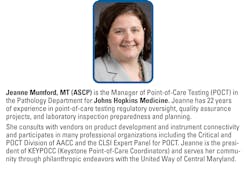Managing point-of-care testing at a nationally ranked healthcare system
How many POC sites are you responsible for at Johns Hopkins?
Johns Hopkins Medicine has six hospitals: Johns Hopkins Hospital, Johns Hopkins Bayview Medical Center, Howard County General Hospital, Sibley Memorial Hospital, and Suburban Hospital (all in the Maryland area), as well as All Children’s Hospital in St. Petersburg, Florida. In addition, Johns Hopkins has over 120 ambulatory sites. We have 14 point-of-care coordinators in total across the enterprise.
How does the POC program work at a large system like Johns Hopkins?
Standardization is important and helps to facilitate efficiency and best practices for treatments of patients across our health system. Johns Hopkins’ standardized practices include an enterprise information technology platform for POCT middleware, which includes standardized POC test codes in electronic medical records; enterprise POCT policies and procedures; standardized devices and test kits; and standardized workflows.
Standardization can help save money and allow for purchasing power with vendors and manufacturers. An example of how standardization can facilitate best practices with patients is the treatment of cancer. For example, we want the test results for complete blood count and/or tumor markers to be comparable from one hospital to the next.
Another example is diabetic care. At Johns Hopkins we use the same instrument for all fingerstick glucose and HBA1c testing at our ambulatory sites, so no matter where the patient goes, comparable test results can be provided by different disciplines and levels of healthcare providers.
Do the same instrument choices work for all POC tests?
Although standardization is important, there is not always a one-size-fits-all for POCT, so it cannot be expected that each patient can be treated or tested in the same exact manner. For example, the fingerstick glucose test may not be a good choice for testing whole blood glucose in a patient who is in renal failure.
In general, these patients may have swelling in their hands. They may not make good candidates for finger sticks because they could have a lot of tissue fluid in their appendages and their capillary beds that when you stick their finger you may not even get a capillary blood sample. It could be mostly tissue fluid and will not be a representative sample of the glucose that is circulating in the patient’s bloodstream.
How can lab facilities enhance their POCT programs?
Expect high-quality POCT results and continue monitoring the quality of your program.
Four ways to achieve this are as follows:
- Follow manufacturers’ instructions for use.
- Evaluate all three stages of POCT as you would with laboratory testing (pre-analytic, analytic, post-analytic).
- Look for guidance from experts in the field through CLSI documents.
- Network at meetings to share experiences with colleagues and become a member of associations such as AACC.
Communication and education are also important; it is important for us to make sure that we educate our ordering providers on the usability of the test and the test results.
Again, going back to the patient in renal failure, educating providers that the glucose finger stick may not give a true glucose result. Or patients who are in intensive care units could have a central line with additional lines in their arms or hands. There’s medications and fluids pumping through those lines. Similarly, if a clinician pulls a sample off of that, they could be pulling out a sample that is a little bit of blood and mostly IV fluids.
What are your tips for expanding the POCT regimen across organizations with multiple test sites?
Learn what needs your units/providers have. The physicians and other clinicians who perform POC tests to get their test results are your customers as equally as the patients who are receiving the results.
Maintaining open lines of communication is important. If a provider questions or doubts a result from their POCT, we have a process by which they can report the test result in question, along with some additional details, so that we can investigate appropriately. This allows us to keep and build the trust of the providers and allows them to maintain confidence in the POCT they use for patient care.
Learn what metrics physicians and other clinicians in your organization are trying to improve (for example, lengths of stay in the emergency department, hospital readmissions, patient satisfaction) and how POCT can assist in those goals.
At Johns Hopkins, we practice patient-centered care, and one of the primary focuses of patient-centered care is that the patient truly is the center of all treatments. Patients have their own care teams. They have doctors, nurses, nutrition services, individuals cleaning their room, etc.
Everybody who has anything to do with all the services that patients receive are part of that care team. And, so, I break that down and remind my fellow point-of-care coordinators that we are an important piece of that puzzle because we support the clinical teams that are putting their hands on the patients.
Have you had staffing challenges as a result of the pandemic or “Great Resignation”?
Yes, there has been high turnover in all clinical staff who do POCT. We’ve hired so many temporary nurses and respiratory therapists that we are in a constant state of training and adding new testing personnel. We have also expanded training across medical teams on POCT. Per CLIA, a clinical technician with a high school diploma can perform glucose testing, so we have utilized them whenever possible.
In addition, many of our point-of-care coordinators have had to go back on the bench and do other lab work in addition to the point-of-care responsibilities they have. And just like other health systems all over the world, we have asked nurse managers who have not done patient care in years to go back to the bedside during COVID, and we’ve even called back retirees.
Is this POCT program unique to Johns Hopkins or are you familiar with other facilities that have similar programs?
I’m happy to say that there are many of my colleagues across the country who have developed similar POCT programs at academic companions including Mayo, Stanford, Harvard, Yale, and the University of Maryland medical system. Next to us here in Maryland, we also have MedStar Health, a local health system with a similar program. These organizations may have any combination of POCT manager, supervisors, or even a lead staff member who make up their POCT program team.
What type of staffer is involved in the POCT program?
We require someone who is not an entry level med tech, but someone who has been on the bench for several years. We prefer someone with three to five years of experience, or sometimes five to ten years of experience.
Good POCT candidates are savvy problem solvers, successful communicators, and good at managing their time. In addition to med techs, the clinicians who are testing personnel may be nurses, assistant nurses, or radiologic technologists in the cardiac cath lab.
How do you deal with errors in the POC tests?
On rare occasions we’ve had to have instruments replaced by the vendors. We have wonderful relationships with our vendors. Laboratory medicine is not a perfect science. We do accept a certain margin of error and humans are the cause of many of them, sometimes it is nothing more than a simple human error. Having successful and meaningful communication with our clinicians gives us a great tool to reduce human errors and provide high-quality POCT results.
Will you be expanding your POCT program? If so, what part of the POCT program will you focus on next?
We have many OR providers who are looking at different coagulation instruments right now. There are several choices on the market, and we are evaluating many of those to find the right fit. We are also looking at the future of molecular POCT. We have a couple of the current molecular platforms in our program and are always looking at what will be offered in the future.
What is your favorite takeaway for clinicians involved in POCT?
The possibilities of being able to perform diagnostic laboratory medicine at the bedside is promising. However, POCT is not a magic fix for all your problems.
Christina Wichmann, Senior Editor, Medical Laboratory Observer | Endeavor Business Media

